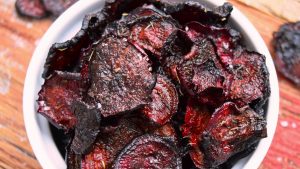
The term ‘beet’ is a shortened version of the actual name of the root vegetable, ‘beetroot.’ It is also referred to as garden beet, blood turnip, and red beet, though not all varieties of beetroot are red. You may also see Chioggia (candy cane), golden & white sugar beets as a part of our harvest, all of which have a slightly milder and sweeter flavor profile than the red beetroot.
Belonging to the same family as chard, baby beets are harvested young for their edible roots, stems, and leaves, and have a smooth, creamy flavor with a slight earthiness. The beet leaves have a similar taste as Swiss chard. Their small size cuts down cooking time.
Beets are particularly rich in folate, especially when consumed raw. Beets are also high in manganese and fiber, both soluble and insoluble. Beet greens are also incredibly nutritious and provide an excellent source of vitamins A, C, and K among other vitamins and minerals. Beet greens are sweet, mild, and cook up into the silkiest, most tender greens you’ll ever eat. They’re much sweeter than kale, and the leaves cook up as silky as spinach. The greens are commonly eaten raw, juiced, or sautéed.
To Store:
Beet greens are packed with nutritional value but must be prepared separately. Upon storage, the greens will quickly draw the moisture from the root greatly reducing flavor and the beets will become shriveled so remove the greens and leave a one-inch stem on the taproot to retain moisture and nutrients. After separating, beets store well for about a week in perforated plastic bags in the refrigerator. Store greens wrapped in a damp cloth or in a plastic bag in a drawer of the refrigerator. Beet can also be frozen or pickled for long-term storage.
Preparation:
Wash beets carefully without breaking the skin. Breaks and tears allow color and nutritional value to escape. Raw beets need only to be scrubbed and their skin can be left on before being grated, sliced, or cubed. If you are cooking beets, you can either peel the beets beforehand or after, depending on the manner in which you’re cooking them. After cooking, the skin can typically be rubbed away once the beets have cooled.
Beets are known for their powerful red pigment which stains dish towels, wooden cutting boards, and sinks so be careful what surfaces come in contact with the beets. If your hands get stained while preparing the beets, salt easily removes the stains from the skin if you use it as a scrub.